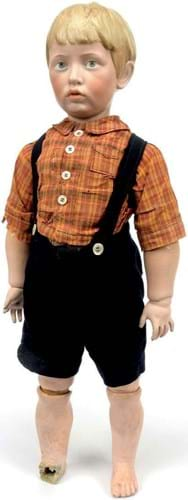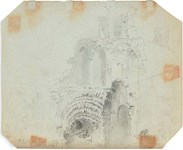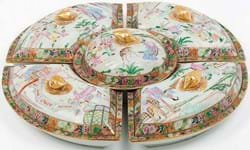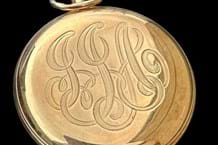A Kämmer & Reinhardt Walter 102 bisque antique character doll, with one obvious condition flaw, may not have impressed a canine playmate but bidders worldwide proved to have more of a taste for its charms.
This doll, ’the urchin’, in original cotton and woollen shorts clothing, was consigned to Vectis in Teesside by an owner who inherited it from her grandmother.
A buyer from Germany lost out to a phone bid from the US when the hammer fell at £43,000 (plus 22.5% buyer’s premium) in the Doll and Teddy Bear sale on June 6, against an estimate of £12,000-17,000.
The company that made it was founded in 1886 in Waltershausen, Thuringia, by Ernst Kämmer and Franz Reinhardt. Up to 1909 K&R concentrated on mass-produced pretty faced dolls, as with other German manufacturers, but the latest models were versions that had expression and realIsm – a new era.
Doll design competition
In 1908 at the Hermann Tietz department store in Munich, the store manager decided that a doll design competition could create interest among customers when purchasing dolls. One stipulation was that any dolls entered must resemble realistic street urchins.
Under the direction of Marion Kaulitz from her Munich Art Studio, a group of dolls known as the Munich Art dolls were entered into the competition.
Inspired by the response, the so-called 100 series was sculpted for K&R by the German artist Arthur Lewin-Funcke (1866-1937). The models, designed to be bought by adults in the years before the First World War, were based on real children in the 1909-12 period, including his own. They were renowned for their lifelike appearance.
An identical sculpture, Knabenbuste, was modelled by Lewin-Funcke in 1898 and then, in 1910, was transformed by him into this ‘urchin’ model for K&R’s art character reform series.
Vectis says: “Few examples are known to exist, and the doll is one of the world’s rarest in this larger size with fine modelling, intensity of expression and translucent painting.”
The model 102 is distinctive for the moulded and painted hair and comes only in 12in and 22in sizes (as here) with painted eyes.
A doll from this series currently holds the world record price for a bisque doll at auction, Vectis adds.
Bonhams Knightsbridge sold a K&R 108 character doll from 1909 for a premium-inclusive £242,500, in September 2014, also designed by Lewin-Funcke. There are no other known examples of that doll, which has unique pierced ears and is thought to be from an experimental mould.
The model 100 mould was the most widely manufactured and popular doll in the series – known as the ‘Kaiser baby’ – so is common. Among the child moulds the 101 is the most often found today, and the most affordable.















